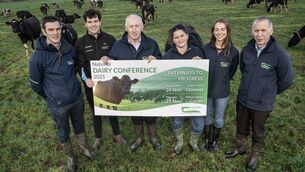How to choose and set your 2025 silage goals

Since silage harvesting and production is also a major cost to farmers each year, best practices are crucial, and silage quality should not suffer by chasing quantity.
As we approach mid-to-late spring, it is worth considering the key steps in the silage-making process to maximise nutritional quality and minimise nutrient losses.
About a million hectares of first-cut silage will be harvested in Ireland this year. Since silage harvesting and production is also a major cost to farmers each year, best practices are crucial, and silage quality should not suffer by chasing quantity.
It is important farmers have targets set out they want to achieve when making silage. Some farms will have a higher requirement for good-quality silage than others. It is all down to the system they are running.
But for certain, all farms need to have a good stock of top-quality silage to have available for milking cows, as from what we see, silage is typically in milking cows’ diets for the first 60 to 90 days at the very least.
It is not necessary to have all good-quality silage in the yard heading into winter in spring-calving herds. If possible, aim to make enough very good-quality silage for milking cows and a separate pit of average-quality silage for dry cows.
If the option is not there to make multiple pits, it is important to make good-quality silage and look at diluting the energy with straw where possible.
The aim on farms should be a silage with an ME above 11.5 MJ/kg, a dry matter of about 30% and a crude protein of at least 14%.
Dry matter digestibility (DMD) is an indicator of the feeding value of a forage crop. In grass silage, it refers to the percentage of grass dry matter (DM) an animal must digest to support its feed requirements.
DMD is very important for your livestock, as it promotes milk production, carcass growth and general herd health. It’s important to look past DMD and look at crude protein, ME and NDF, and this is what factors in your overall DMD figure.
A higher DMD value corresponds to higher-quality silage the animal can efficiently utilise. Ideally, 74% DMD or greater is needed to maximise energy and dry matter intakes of silage, especially as more milk production is coming from forage in early and late lactation, when weather patterns are unfavourable for grazing.
Cows fed on 75% DMD silage require 3-4kg less concentrates to achieve similar milk solids to cows fed on 69% DMD silage. This is a potential saving of €0.90 c/cow/day in concentrate savings.
For high-DMD silage, the grass sward needs to contain lots of good-quality, leafy grass. As the crop starts to bulk up and yield increases, quality declines as the grass begins to produce stems and heads. These are less digestible than leafy growth.
While this will compromise yield, earlier cutting of first and second cuts may allow an extra later cut depending on the season. Any grass carried over the winter should also have been grazed off the silage ground in the first rotation to allow a fresh growth of leafy grass.
Weeds in the grass will lower the DMD, so by reducing the number of weeds, the quality of the silage can be improved.
In theory, silage is a very simple game, but in reality, it is the very opposite. Aim to control what you can and be ready for what the weather throws at you then. Ensure fertiliser is out in time and that you’re ready to go when the weather allows.
Do not be tempted to cut grass closer to the ground to add quantity, as this risks taking soil into the pit, leading to an unfavourable fermentation. It also increases the amount of stalk or fibre in the clamp, reducing nutritional quality.
Maintaining a cutting height of 6-7cm is recommended to allow good regrowth and minimise soil contamination. This will also allow the grass to sit above ground level and allow a small bit of air circulation under the crop.
- Next week, Thomas O'Sullivan will look at wilting and fermentation













